Queensland budget: Covid forces $12.3bn collapse in state’s revenue
Total debt will hit nearly $130bn for the first time by the middle of 2024.
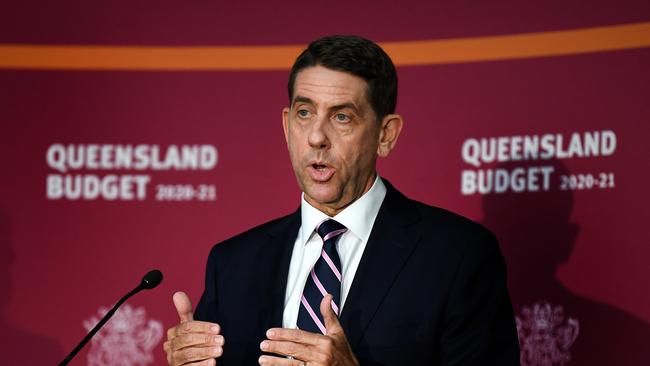
Queensland’s total debt will hit nearly $130bn for the first time by the middle of 2024, as COVID-19 forces a $12.3bn collapse in revenue over the next four years.
Delivering his first full budget as Treasurer, Cameron Dick said the huge increase in borrowings – a forecast hike of $28bn in three years – was unavoidable due to the pandemic-sparked economic downturn, warning it was possible Queensland could be put on a “negative outlook” by ratings agencies.
Queensland Premier Annastacia Palaszczuk also warned the escalating trade tensions with China could force coal mines in the state to close, threatening the forecast rebound in employment and economic growth.

She said she would raise the issue at national cabinet next week, and urged the federal government to resume trade talks with China as soon as possible, to preserve Queensland’s “strong” relationship with its trading partner.
Some of the coal ships sitting off Chinese ports in limbo were carrying Queensland coal, Ms Palaszczuk confirmed.
“We would encourage the federal government to resume trade relationship talks because what the mining companies are saying to me is that the last thing they want to see is mines closed in Queensland that could have an impact on Queensland jobs,” she said.
“We have been advised that companies are fearful of what could happen in the future if those trade issues are not sorted out.”
The budget position assumes Australia’s trade arrangements with China will normalise in 2021-22.
DEBT
Mr Dick said Queensland’s total debt of $129.7bn by 2023-24 “pales beside” forecasts posted by NSW ($190bn) and VIC ($192bn).
“And unlike those states, Queensland has kept our public assets in public hands. Keeping public assets in public hands has meant that the revenue these assets generate remains in public hands,” Mr Dick told parliament.
“While NSW and VIC will have total debt levels exceeding 190 per cent of revenue by 2024, Queensland’s figure will be 174 per cent.”
The new figures were included in a belated budget delivered after Queenslanders re-elected the Palaszczuk government for a third term on October 31. The document reflects the chaos wrought by the coronavirus pandemic, a huge hit to revenue from exports, GST and taxes, and the government’s election promises.
Forecast borrowings have exploded in Queensland since COVID-19 struck. At last year’s budget, total debt was expected to hit $90.71bn by mid-2023. In Tuesday’s budget papers, total debt is forecast to reach $122.7bn by that date, a blowout of $32bn.
Ahead of the state election, Mr Dick told Queenslanders he would need to borrow $4bn over the next four years to pay for election promises, as well as extra to fund deficits.
On Tuesday, he told parliament that debt servicing costs were low and it would be fiscally irresponsible to do anything other than increase debt.
“To do anything other than borrow to rebuild would condemn our economy to years of austerity and a far slower and more painful recovery,” he said.
General government sector net debt – excluding borrowings by government-owned corporations – will hit $50.7bn in 2023-24, with interest payments reaching nearly $2bn in that financial year.
“Our debt servicing costs will represent three per cent of our total revenues across the forward estimates,”
He said interest costs peaked at 4.7 per cent during the Newman LNP government in 2013-14.
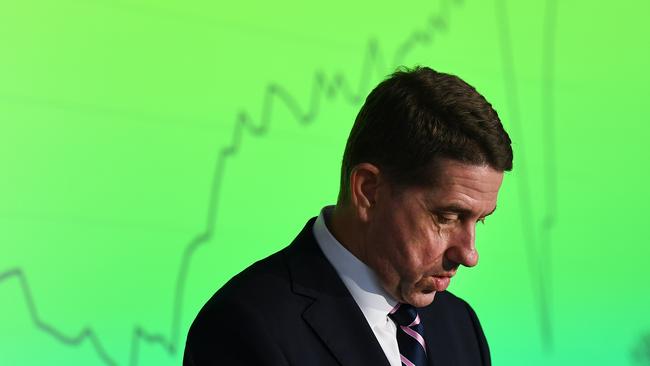
REVENUE AND DEFICITS
COVID-19 has slashed revenue, due to industry downturns and the impact of relief measures.
The budget says since the 2019-20 mid-year update delivered in December last year, revenue had been revised down by $12.3bn over four years.
Forecast tax revenue has plunged $4.5bn, GST is down $3.8bn and royalties – particularly coal – are down $4bn compared to the December fiscal update last year.
Queensland offered payroll tax refunds and deferrals to some businesses, land tax rebates, and a deferral of gaming machine taxes as a result of the pandemic.
“As we made clear in the election campaign, in the face of this revenue collapse, it would be reckless and irresponsible to promise a budget surplus at this time,” Mr Dick told parliament.
Queensland’s overseas exports of goods and services are expected to fall by 11 per cent in 2020-21, before rebounding by 9.75 per cent in 2021-22.
Demand for Queensland coal, LNG, and international education has dived.
“Reflecting the reduced demand in the first quarter, the continued impacts of COVID-19 and the uncertainty surrounding Australian access to the Chinese market, Queensland’s coal exports are forecast to fall eight per cent in 2020-21,” the budget papers read.
But coal exports are expected to recover by nearly 10 per cent in 2021-22.
Coal royalties dived from $4.3bn in 2018-19 to $1.6bn in 2020-21.
“This decline across the two years is driven by lower coal prices and volumes, reflecting weaker global economic growth, which was exacerbated significantly by the pandemic,” the budget papers say.
Queensland’s budget will languish in deficits for at least four years. The skinny surplus predicted in last year’s budget for 2019-20 of $189m plunged into an actual operating deficit of $5.7bn. In 2020-21, the deficit will rise to a peak of $8.6bn, compared to the $313m surplus forecast last year.
But the deficits are projected to decrease in size as time goes on, with a deficit of $1.4bn predicted in 2023-24.
“I make it clear today that the budget will only return to balance when the economy returns to normal,” Mr Dick said.
He did not nominate a year when the budget would return to surplus.

ECONOMIC GROWTH
The budget predicts that – due to Queensland’s success in containing the spread of the COVID-19 virus – the June quarter is expected to be the “lowest point in the COVID-19 economic cycle”.
The Queensland economy is forecast to return to marginal growth in 2020-21 (up one-quarter of one per cent) but that is still far lower than the pre-COVID forecast of 2.75 per cent in 2020-21. Gross state product growth is forecast to significantly improve next financial year in 2021-22 when it is expected to reach 3.5 per cent.
According to Treasury figures, Queensland’s GSP growth is better than anywhere else in Australia – apart from WA – for 2020-21. The Commonwealth GDP growth is -1.5 per cent, NSW is -0.75 per cent and Victoria is -4 per cent.
UNEMPLOYMENT
Mr Dick warned it could take as long as four years before the “impact of COVID-19 on employment is offset,” primarily because a COVID-19 vaccine is only predicted to be widely available by late next year, meaning a delayed return of international tourism.
The budget is predicated on the assumption that interstate borders were not expected to fully reopen until late this year, while international borders were expected to stay closed until at least the second half of next year.
As at September, Queensland’s unemployment rate was forecast to peak at nine per cent in the December quarter. But Tuesday’s budget papers have a more positive outlook.
In fact, the unemployment rate is already expected to have peaked in quarterly terms at 7.9 per cent in the September quarter, and is forecast to improve steadily to be 6.5 per cent by June 2024.
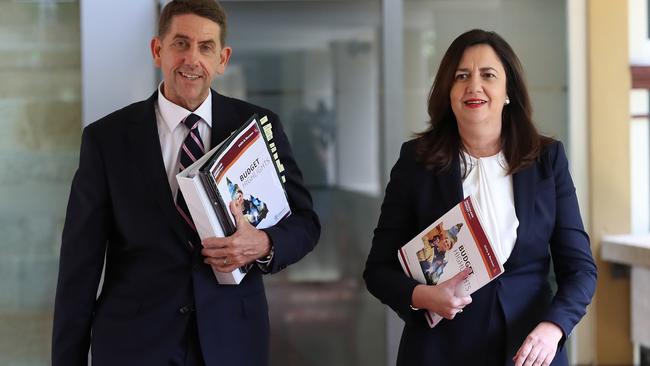
SPENDING
Government expenses leapt by nearly eight per cent in 2019-20, and general government expenses have increased by nearly $11bn over 2019-20 to 2022-23.
Expenses for 2020-21 are estimated to be $64.9bn, an increase of $1.3bn from last financial year, representing the COVID-19 health and economic response, with about 55 per cent of expenses spent on health and education.
Mr Dick said infrastructure and capital works spending would be $56bn over four years, “which is a record spend over the past decade”. $1.5bn will be spent to continue building the government’s largest infrastructure project – the Cross River Rail public transport tunnel.
But the capital spend is less than the Queensland record – set by the Bligh government in the 2009-10 Global Financial Crisis budget, which forecast a capital spend of $56.2bn over four years.
Total health funding is $21.8bn in 2020-21, including $265m to build seven satellite hospitals around the state as promised in the election.
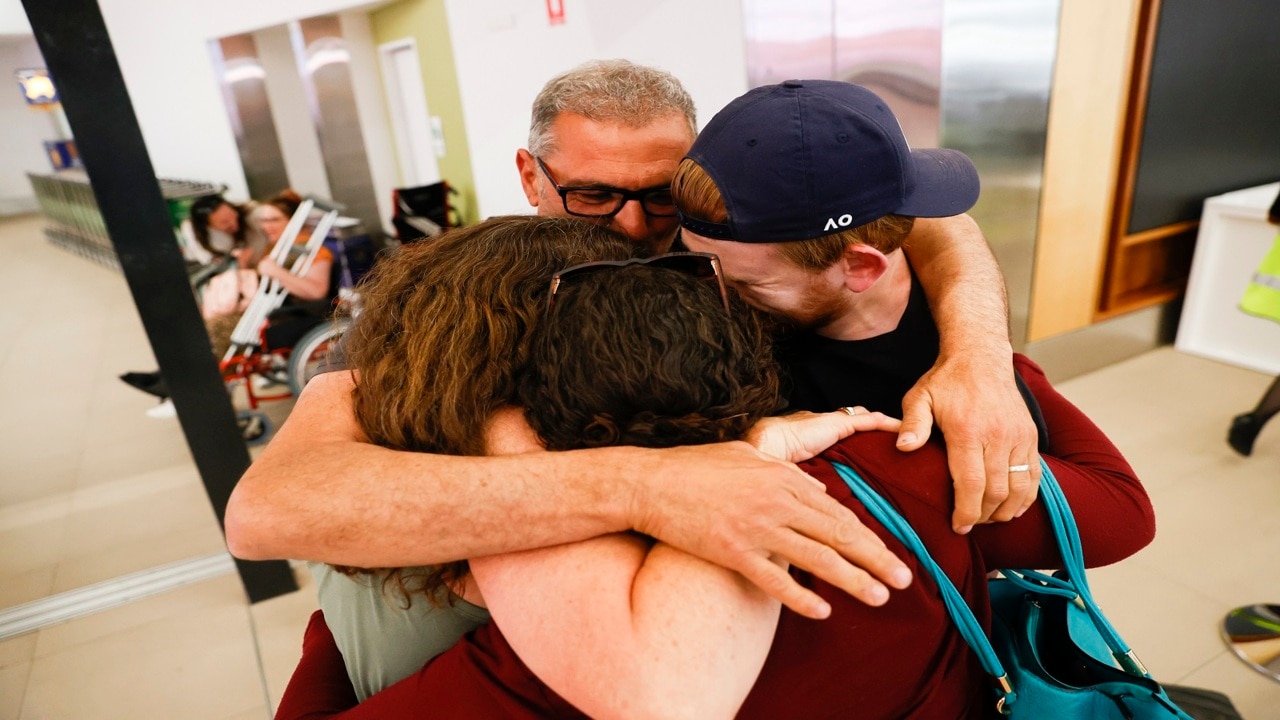
As Queensland reopens its borders to greater Sydney and Victoria on Tuesday, just $74m in specific funding is being dedicated to the tourism recovery, while the government is trumpeting $600m in spending on building trains in Queensland through an investment in Maryborough-based Downer EDI.
The Treasurer said the strength of the agriculture and mining sectors – particularly coal – had “protected our economy from some of the worst effects of the COVID-19 downturn”.
COST-CUTTING
Senior executive service roles within the government will be reduced “naturally” as part of a ream of cost-cutting measures designed to save $3bn over four years.
According to the budget papers, the government has already saved $352.2m – 47 per cent of its 2020-21 savings target.
But more efficiencies will need to be made to achieve the targets of the “savings and debt plan”.
Secondments of frontline workers to back-office roles will be limited and employees will be encouraged to work closer to home in existing government buildings to cut costs.
PUBLIC SERVICE
Delivering his budget speech to parliament, Mr Dick said: “We will do what Labor governments always do, we will always invest in the frontline and we will always back our frontline workers”.
Frontline job increases will prompt employee expenses to rise 3.2 per cent to $26.47bn, an increase of $810m to the public service wage bill.
This compares with an increase in 2019-20 of 5.4 per cent or $1.3bn.
The relative reduction in employee expenses growth is driven by a wage freeze for public sector employees designed to offset the impact of its COVID-19 measures.
Employees whose wages will increase following the freeze will not be back-paid, meaning the freeze will save the government about $780m over two years.
A further 6,168 full-time jobs will be created in the public service in 2020-21.
Growth in the health sector will be higher than the rate of population growth, while education and other sectors will be essentially in line with population growth.
Since the Palaszczuk Government came to power in 2015, following the Newman Government’s axing of 14,000 public service jobs, the number of full-time public service roles has increased by 33,133, a rise of 16.6 per cent.
According to the budget papers, about 47 per cent of public service jobs are located outside greater Brisbane.






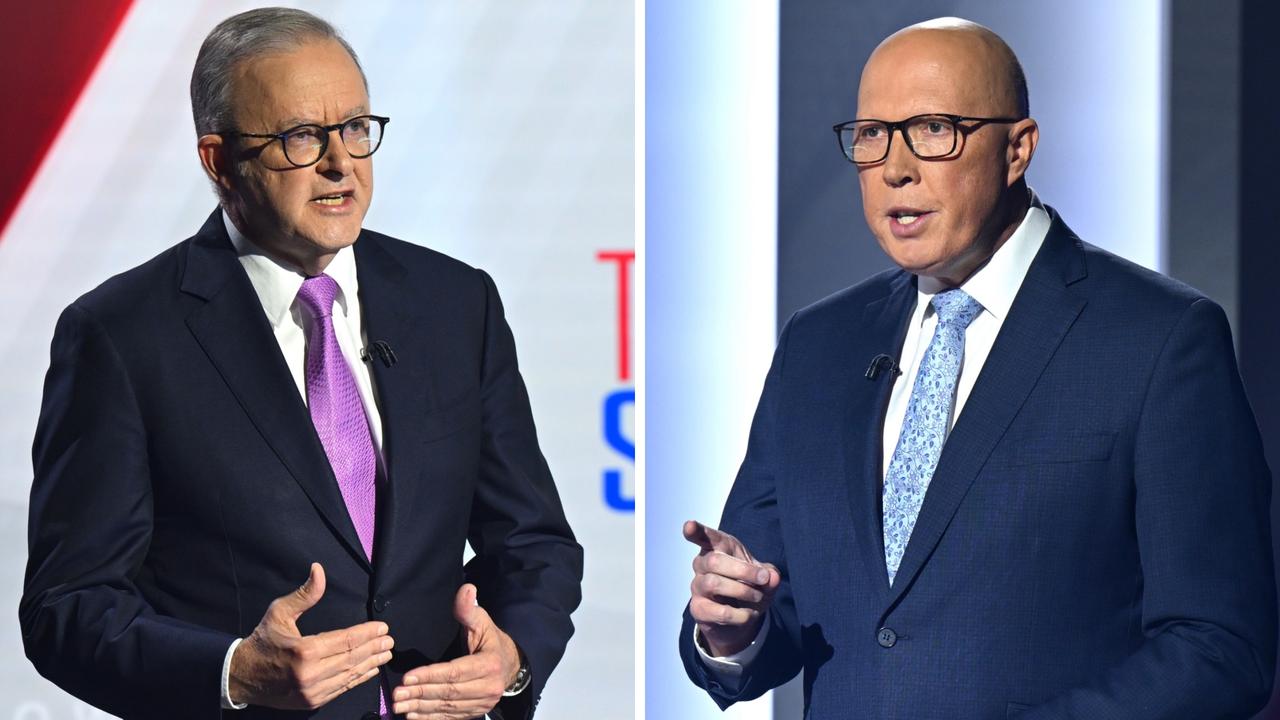
To join the conversation, please log in. Don't have an account? Register
Join the conversation, you are commenting as Logout